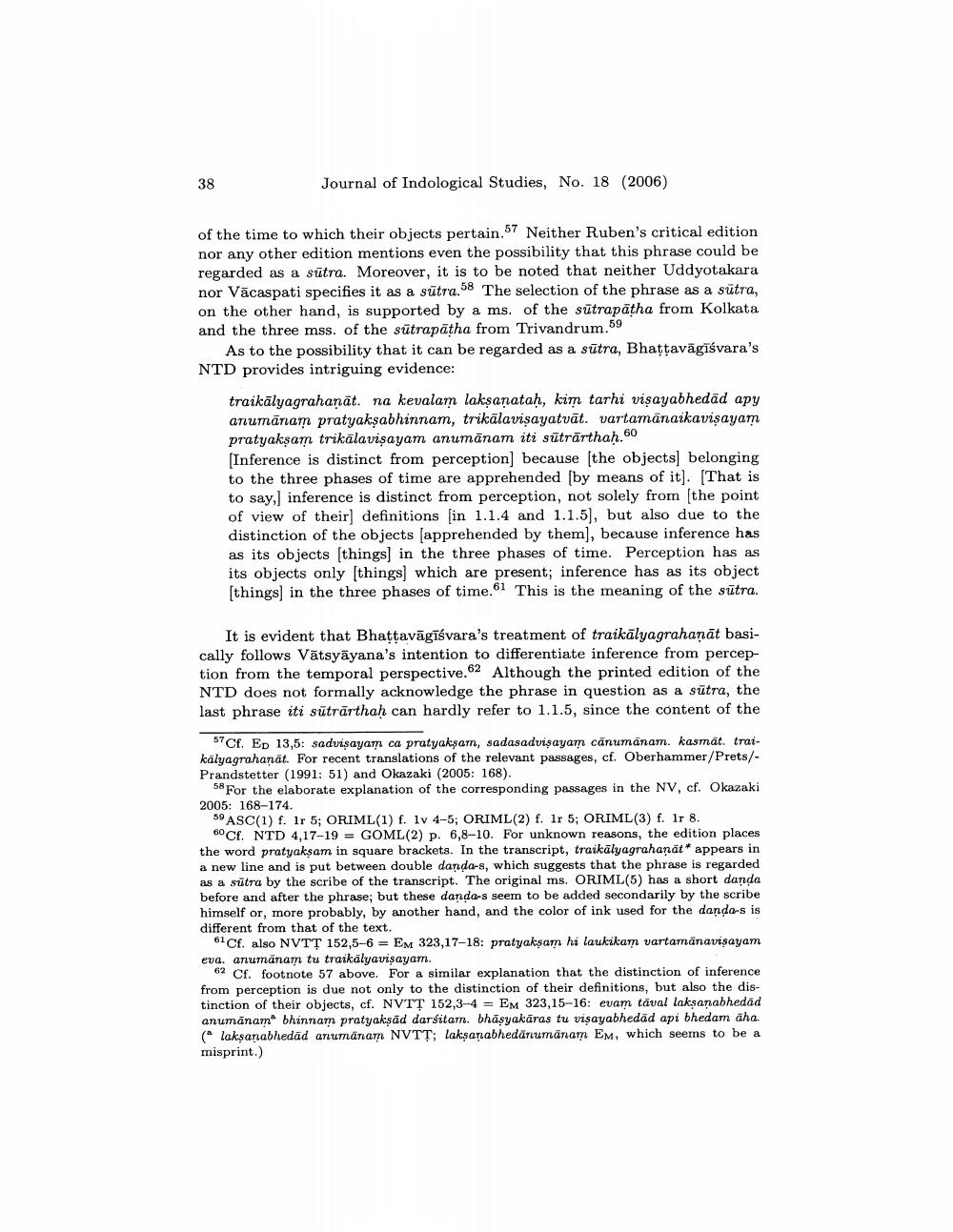________________
38
Journal of Indological Studies, No. 18 (2006)
of the time to which their objects pertain.57 Neither Ruben's critical edition nor any other edition mentions even the possibility that this phrase could be regarded as a sutra. Moreover, it is to be noted that neither Uddyotakara nor Vacaspati specifies it as a sutra.58 The selection of the phrase as a sutra, on the other hand, is supported by a ms. of the sutrapatha from Kolkata and the three mss. of the sutrapatha from Trivandrum.59
As to the possibility that it can be regarded as a sutra, Bhaṭṭavägiśvara's NTD provides intriguing evidence:
traikalyagrahanat. na kevalam lakṣaṇataḥ, kim tarhi viṣayabhedad apy anumanam pratyakṣabhinnam, trikalaviṣayatvät. vartamanaikaviṣayam pratyakṣam trikalaviṣayam anumanam iti süträrthaḥ.6 [Inference is distinct from perception] because [the objects] belonging to the three phases of time are apprehended [by means of it]. [That is to say,] inference is distinct from perception, not solely from [the point of view of their] definitions [in 1.1.4 and 1.1.5], but also due to the distinction of the objects [apprehended by them], because inference has as its objects [things] in the three phases of time. Perception has as its objects only [things] which are present; inference has as its object [things] in the three phases of time.61 This is the meaning of the sutra.
60
It is evident that Bhaṭṭavägiśvara's treatment of traikalyagrahaṇāt basically follows Vatsyāyana's intention to differentiate inference from perception from the temporal perspective. 62 Although the printed edition of the NTD does not formally acknowledge the phrase in question as a sutra, the last phrase iti sūtrarthaḥ can hardly refer to 1.1.5, since the content of the
57Cf. ED 13,5: sadviṣayam ca pratyakşam, sadasadviṣayam canumanam. kasmāt. traikalyagrahanät. For recent translations of the relevant passages, cf. Oberhammer/Prets/Prandstetter (1991: 51) and Okazaki (2005: 168).
58 For the elaborate explanation of the corresponding passages in the NV, cf. Okazaki
2005: 168-174.
59 ASC(1) f. 1r 5; ORIML(1) f. 1v 4-5; ORIML(2) f. 1r 5; ORIML(3) f. 1r 8.
60 Cf. NTD 4,17-19 = GOML(2) p. 6,8-10. For unknown reasons, the edition places the word pratyakṣam in square brackets. In the transcript, traikalyagrahaṇat* appears in a new line and is put between double danda-s, which suggests that the phrase is regarded as a sutra by the scribe of the transcript. The original ms. ORIML(5) has a short danda before and after the phrase; but these danda-s seem to be added secondarily by the scribe himself or, more probably, by another hand, and the color of ink used for the danda-s is different from that of the text.
61 Cf. also NVTT 152,5-6 EM 323,17-18: pratyakṣam hi laukikam vartamanaviṣayam eva. anumanam tu traikalyaviṣayam.
62 Cf. footnote 57 above. For a similar explanation that the distinction of inference from perception is due not only to the distinction of their definitions, but also the distinction of their objects, cf. NVTT 152,3-4 EM 323,15-16: evam taval lakṣaṇabhedad anumanam bhinnam pratyakṣäd darsitam. bhāṣyakāras tu viṣayabhedad api bhedam aha. (a lakṣaṇabhedad anumanam NVTT; lakṣaṇabhedanumanam Em, which seems to be a misprint.)
=




